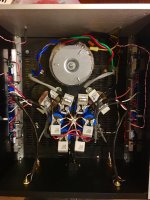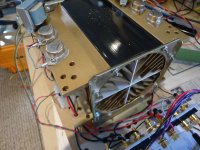Thanks for the detail Hikari. Seems you have really customised this build to suit your tastes, that's DIY done right🙂. I have Aleph 2s, and I can hear the difference when they are warm. The bias increases, and they sound much better, so I agree with you. I would be a bit nervous of running a mosfet that hot though. I think anything over 25W is maybe cutting into their life expectancy. I have not experimented with different mosfets, and I wan to try some Toshibas soon and see how they are, so thanks for the feed back.
Just a thought, as this is DIY, why not build two of them with 24 volt rails. Bi-amp and address your volume issue this way, best of both worlds🙂
Hi Luke and Hikari !
Great idea, i was just wondering if you could use two F5s in parallel or on a bridge cofiguration.
You can certainly do that. Although it probably makes more sense to use something with more wattage or class a/b on the bass and F5 on the highs.
Is that based off the Diyaudiostore boards?I have it removed although I had it set to 10A before removal.
Yes, they are the standard F5 boards...I think they are the earlier ones (no P3).
I added another pair of mosfets with leads...the boards are not F5T boards.
I added another pair of mosfets with leads...the boards are not F5T boards.
I have it removed although I had it set to 10A before removal.
I have a pair of 2sj49/2sk134
Can i use their for much more sonically performances?
I like that! Would you recommend that for what I'm working with?Yes, they are the standard F5 boards...I think they are the earlier ones (no P3).
I added another pair of mosfets with leads...the boards are not F5T boards.
I have a pair of 2sj49/2sk134
Can i use their for much more sonically performances?
No. They are lateral mosfets.
I like that! Would you recommend that for what I'm working with?
You could certainly try it.
But when using multiple pairs the mosfets must be matched. So you would need to replace all the mosfets anyways. At that point you might as well use the correct boards.
In V3 version appears optional C3 and C4 in values ranging around 1 nF between out and gates through gate resistors.
What does you think about?
What does you think about?
There aren't supposed to be any caps in an F5.In V3 version appears optional C3 and C4 in values ranging around 1 nF between out and gates through gate resistors.
What does you think about?
It's all in Nelson's PDF:
http://www.firstwatt.com/pdf/art_f5_turbo.pdf
They small capacitors are to prevent ringing/overshoot. They limit bandwidth. Probably only needed with 35+V rails.
http://www.firstwatt.com/pdf/art_f5_turbo.pdf
They small capacitors are to prevent ringing/overshoot. They limit bandwidth. Probably only needed with 35+V rails.
There aren't supposed to be any caps in an F5.
Ok!
Many Thanks for your advices!🙂
Just curious.... Is it possible, or has anyone ever tried building an F5 with power JFETs in the output stage?
you have plenty of Sony VFet based amps here, in last few years
choose one .... and maybe you'll pick one most resembling F5

choose one .... and maybe you'll pick one most resembling F5

Happiness is an F5 running decent bias with good temps. Last week I dug into the thing again to replace some heatsink compound with some better silver stuff. In the process I discovered a reliable way of splitting mica insulators in half with a pair of tweezers. Solidly running 1.3 amp of bias now, I can get a good 10 seconds of skin contact on the MOSFET cases. I might try for a tad more and call it as good as possible. I'm surprised how much of a difference splitting those things with better compound made. Thanks for all the help and kindness!
- Home
- Amplifiers
- Pass Labs
- F5 power amplifier


